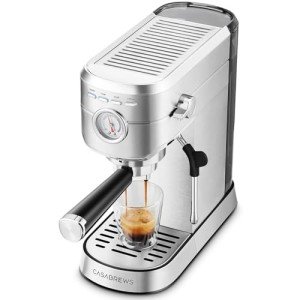The World of High-Quality Espresso Machines: A Comprehensive Guide
Espresso has actually become a beloved beverage among coffee lovers worldwide, understood for its abundant flavor, intense scent, and versatility. The heart of a terrific espresso lies in the machine utilized to brew it. High-quality espresso machines are designed to provide the perfect shot, making them an essential investment for coffee enthusiasts. This post explores numerous kinds of high-quality espresso machines, their features, upkeep ideas, and answers to regularly asked concerns.
Kinds Of High-Quality Espresso Machines
High-quality espresso machines fall under numerous categories, catering to various choices, ability levels, and spending plans. The primary types consist of:
| Type of Machine | Description | Suitable User |
|---|---|---|
| Manual Espresso Machines | Requires user skill to control extraction and pressure. Offers the most control over the developing procedure. | Experienced baristas and enthusiasts |
| Semi-Automatic Machines | Combines manual operation with automation. Users manage the grind and tamping, while the machine deals with water dispersion. | Intermediate users |
| Automatic Espresso Machines | Automate the developing procedure, permitting for programmable brewing times and temperature levels. | Casual coffee drinkers |
| Super-Automatic Machines | Have built-in mills and are fully automated, handling everything from grinding to brewing and steaming. | Users seeking convenience |
| Commercial Espresso Machines | Developed for high volume use in cafes and restaurants, offering durability and speed. | Service owners |
Comprehensive Overview of Each Type
Manual Espresso Machines
- Pros: Complete control over the brewing procedure; can produce exceptional quality espresso.
- Cons: Requires substantial ability; lengthy.
Semi-Automatic Machines
- Pros: Balanced control, mixing manual and automatic processes; remarkable quality espresso is still possible.
- Cons: Requires some understanding and experience to master.
Automatic Espresso Machines
- Pros: User-friendly; lowers the learning curve while still producing high-quality espresso.
- Cons: Still needs some understanding of coffee-making basics.
Super-Automatic Machines
- Pros: Maximal convenience; little ability needed; ideal for people or households who desire coffee without hassle.
- Cons: Higher cost point; might do not have the fine-tuning capabilities of manual machines.
Commercial Espresso Machines
- Pros: Built for longevity and performance; typically includes features for high-volume turns.
- Cons: Expensive; may be overkill for home use.
Secret Features to Consider
When searching for a high-quality espresso machine, a number of key features need to be taken into consideration:
- Pressure and Pump Type: Look for machines with a minimum of 9 bars of pressure, which is important for extracting the best taste from coffee beans.
- Boiler Type: Single, double, and heat exchanger boilers each affect how the machine carries out and the speed of developing.
- Construct Quality: High-quality materials such as stainless-steel are preferable for sturdiness and looks.
- Reduce of Use and Cleaning: Some machines require comprehensive cleansing, while others are designed for simple upkeep.
- Temperature level Control: Consistent temperature is crucial; think about machines with PID controllers for exact control.
Benefits of High-Quality Espresso Machines
Purchasing a high-quality espresso machine offers a wide range of benefits:
- Superior Quality: High-end machines enable greater control, causing tastier espresso.
- Toughness: Built to last, quality machines need fewer repair work and replacements.
- Customization: Users can enjoy a tailored experience by changing grind size, shot timing, and other settings.
- Increased Convenience: Automatic and super-automatic alternatives enable fanatics to enjoy espresso with very little effort.
Maintenance and Care for High-Quality Espresso Machines
To keep an espresso machine operating efficiently, routine maintenance is crucial. Here are suggestions for maintaining a high-quality espresso machine:
Descale Regularly:
- Use a descaling option every couple of months to avoid buildup of minerals from water, which can impact taste and efficiency.
Tidy the Brew Group:
- For machines with a removable brew group, tidy it regularly to make sure a clean extraction.
Replace Water Filters:
- Use a water filter and alter it as required to decrease pollutants in your brewing water.
Daily Cleanings:
- Rinse the portafilter and group head after each use to prevent oil buildup.
Watch on the Parts:
- Monitor seals, gaskets, and other parts for wear and tear and replace them as necessary.
Regularly Asked Questions (FAQs)
1. What is the very best espresso machine for novices?
For newbies, a semi-automatic machine frequently provides a good balance of functionality and control, allowing users to discover the skills required for making terrific espresso.
2. Are super-automatic machines worth the investment?
Yes, for those who prioritize benefit and ease over control, super-automatic machines can be a deserving investment, particularly for families or busy experts.
3. How much should I anticipate to spend on a high-quality espresso machine?
High-quality espresso machines vary significantly in rate, with manual machines beginning at a few hundred dollars, while super-automatic or commercial machines can go beyond a number of thousand.
4. Can I make other coffee beverages with an espresso machine?
Yes, numerous espresso machines have steam wands or accessories that allow users to create lattes, coffees, and more.
5. Best Espresso Machines of time do espresso machines usually last?
With appropriate maintenance, high-quality espresso machines can last over a years, making them a long-lasting investment in your coffee enjoyment.
High-quality espresso machines yield a transformative coffee experience, whether delighted in at home or in a commercial setting. By comprehending the types readily available, their functions, and the maintenance needed to keep them running efficiently, customers can make educated choices that raise their coffee-drinking experience.

